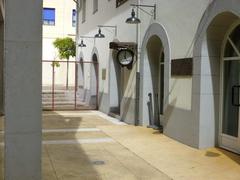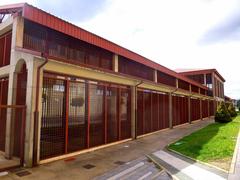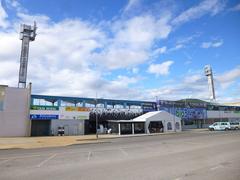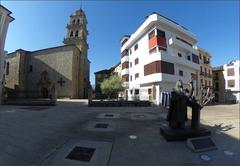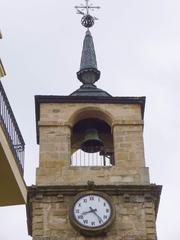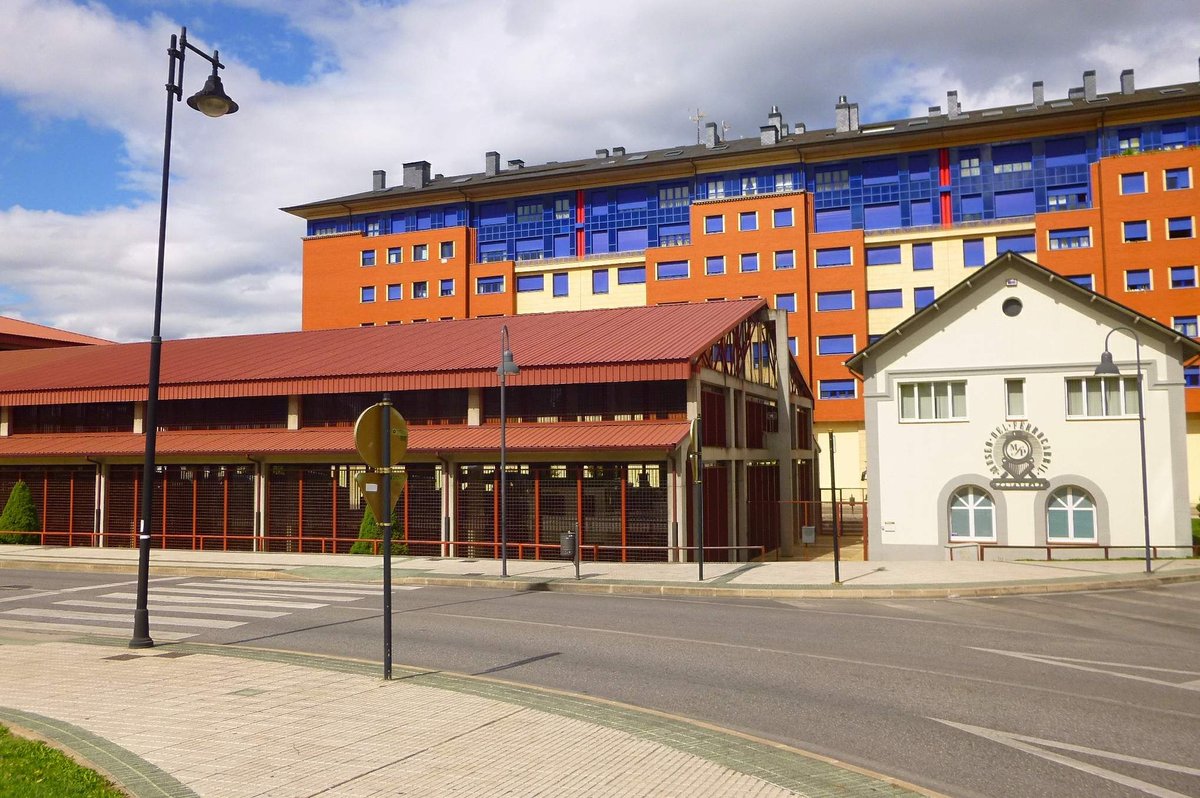
Railway Museum of Ponferrada: Visiting Hours, Tickets, and Travel Guide
Date: 14/06/2025
Introduction: History and Significance
The Railway Museum of Ponferrada stands as a testament to the rich industrial heritage of the El Bierzo region in León, Spain. Located in the historic Minero Siderúrgica de Ponferrada (MSP) station, the museum preserves the legacy of the Ponferrada-Villablino Railway—a narrow-gauge line constructed between 1917 and 1919 to support the booming coal industry. This railway was pivotal in connecting remote mining areas to national markets, facilitating the transport of coal and iron ore, and fostering the growth of local communities until passenger services ended in 1980 (Ponferrada Tourism; Spanish Railway).
The museum’s exhibits include original steam and diesel locomotives, rolling stock, engineering artifacts, and archival documents, providing an immersive exploration of the technological, economic, and social impact of rail transport in the region (WhichMuseum; Turismo Castilla y León). Interactive displays, thematic exhibition zones, and guided tours offer visitors deep insight into railway engineering and the cultural history of Ponferrada.
Surrounded by the scenic Sil River valley and close to historical landmarks such as the Castillo de Ponferrada and the Basilica of Nuestra Señora de la Encina, the museum is an essential stop for those interested in Spain’s industrial and cultural past (Barceló Guide). Modern amenities, accessibility features, and educational programs ensure a welcoming experience for all.
Table of Contents
- History of the Ponferrada-Villablino Railway
- Construction, Operations, and Decline
- The Museum: Exhibits, Layout, and Collections
- Visiting Information: Hours, Tickets, and Accessibility
- Guided Tours, Events, and Educational Programs
- Getting There and Facilities
- Nearby Historical Sites and Attractions
- Tips for a Memorable Visit
- Summary and Essential Information
- Sources
History of the Ponferrada-Villablino Railway
Origins and Conception
The Ponferrada-Villablino Railway (PV) was envisioned in the early 20th century to overcome transportation barriers for the region’s rich coal deposits. Initial proposals began in 1906, but it was not until 1917—under the direction of MSP engineer Pedro Ortiz Muriel—that the project gained momentum. The selected route followed the Sil River, overcoming formidable terrain and connecting Ponferrada to Palacios del Sil and eventually Villablino (es.wikipedia.org; Spanish Railway).
Construction and Early Development
Construction was approved by the Spanish Parliament in 1918 and completed rapidly despite challenging conditions. The railway became operational in 1919, quickly transforming the economic landscape by enabling the efficient transport of coal and iron, and stimulating industrial development in El Bierzo and Laciana (Ponferrada Tourism).
Operations and Economic Impact
The PV operated as a metre-gauge railway, primarily serving the coal industry but also providing vital passenger services until 1980. Its network of branches and sidings catered to numerous mines and industrial plants, fueling the growth of MSP and supporting the livelihoods of generations of workers (es.wikipedia.org).
Decline and Preservation
Demand for coal declined in the late 20th century, leading to a reduction in rail traffic and eventual closure of some sections. By the early 2000s, only a small portion remained operational. Recognizing its historical value, regional authorities and cultural organizations worked to preserve the railway’s legacy, culminating in the establishment of the Railway Museum of Ponferrada in the original station building (es.wikipedia.org; Ponferrada Tourism).
The Museum: Exhibits, Layout, and Collections
Museum Setting
The museum occupies the original MSP station in Compostilla, preserving its industrial character with platforms, sidings, and authentic architectural features (Turismo Castilla y León). Inside, visitors can explore:
- Historic Locomotives: Restored steam and diesel engines, including rare examples from the early 20th century (International Steam).
- Rolling Stock: Coal wagons, passenger coaches, and mining equipment.
- Technical Artifacts: Railway signaling devices, tools, uniforms, and archival photographs.
- Interactive Exhibits: Model railways, multimedia presentations, and hands-on engineering displays.
- Archival Resources: Original blueprints, timetables, and personal accounts of railway workers.
Thematic Zones
- Historical Hall: Chronicles the railway’s construction and regional impact.
- Rolling Stock Gallery: Open-air displays of locomotives and carriages.
- Technical and Engineering Room: Interactive explorations of railway technology.
- Community Zone: Social history and oral narratives.
- Temporary Exhibition Space: Rotating exhibits and model railways.
Educational Programs
The museum offers guided tours, hands-on workshops, and educational resources for families, schools, and enthusiasts. Special programs include demonstrations of steam power and railway safety (Network Rail Educational Resources; Science Museum Group Learning Resources).
Visiting Information: Hours, Tickets, and Accessibility
Opening Hours
- Tuesday to Sunday: 10:00 AM – 6:00 PM
- Closed Mondays and some public holidays
- Seasonal variations may apply, so always check the official website before your visit.
Ticket Prices
- General Admission: €5–€6 per adult (varies by source)
- Reduced Rate: €3 for students, seniors, and children (6–12 years)
- Children under 6: Free
- Groups (10+): Discounts available
- Tickets are available onsite and, in some cases, online for advance purchase.
Accessibility
- Fully wheelchair accessible with ramps, elevators, and accessible restrooms.
- Interpretive materials in Spanish, English, and French.
- Assistance available for visitors with special needs (Camino Adventures).
Guided Tours, Events, and Educational Programs
- Guided Tours: Available daily at set times; advance booking recommended for groups.
- Special Events: Heritage days, model railway exhibitions, and photography workshops occur seasonally.
- Workshops: Educational activities for children and families, focusing on railway history and steam technology.
Getting There and Facilities
Location and Transport
- Address: Calle Alcalde García Arias, 7, 24400 Ponferrada, León
- Public Transport: Regular buses connect the museum with Ponferrada’s city center and train station.
- By Car: Ample free parking is available, including accessible spaces.
Facilities
- Restrooms and Gift Shop: Railway-themed souvenirs, books, and educational materials.
- Information Desk: Multilingual support and maps.
- Nearby Dining: Numerous cafés and restaurants in the city center offer local cuisine (Barceló Guide).
Nearby Historical Sites and Attractions
Enhance your visit by exploring:
- Castillo de Ponferrada (Templar Castle): Medieval fortress near the museum.
- Basilica de Nuestra Señora de la Encina: Significant religious site.
- Light Factory. Energy Museum: Focused on the region’s energy history (WhichMuseum).
- El Bierzo Museum and Herrería de Compludo: Broader insights into local heritage.
Tips for a Memorable Visit
- Plan Ahead: Check the museum website for current hours, ticket prices, and event schedules.
- Combine Attractions: Pair your visit with other historical sites for a full cultural itinerary.
- Photography: The outdoor exhibits are ideal for photos; check indoor restrictions.
- Weather: Dress appropriately for outdoor displays.
- Accessibility: Contact the museum for specific needs.
- Souvenirs: Visit the gift shop for unique memorabilia.
Summary
The Railway Museum of Ponferrada provides a comprehensive view of the region’s industrial and social history, with engaging exhibits, educational opportunities, and accessible facilities. Its strategic location allows visitors to explore Ponferrada’s rich cultural landscape, making it an essential stop for anyone interested in Spain’s railway or industrial heritage. For up-to-date information on visiting hours, tickets, and special events, consult the official museum website and local tourism resources (Ponferrada Tourism; Turismo Castilla y León).
Sources
- Ponferrada Tourism
- Spanish Railway
- WhichMuseum
- Turismo Castilla y León
- Barceló Guide
- International Steam
- Camino Adventures
- Spain.info
- Network Rail Educational Resources
- Science Museum Group Learning Resources


